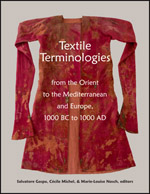Center, Textile Research

Textile Terminologies from the Orient to the Mediterranean and Europe, 1000 BC to 1000 AD
Date of this Version
2017
Document Type
Article
Citation
In Textile Terminologies from the Orient to the Mediterranean and Europe, 1000 BC to 1000 AD, ed. Salvatore Gaspa, Cécile Michel, & Marie-Louise Nosch (Lincoln, NE: Zea Books, 2017), pp. 153-163.
doi:10.13014/K2QV3JQC
Abstract
The main texts of the Rabbinic literature, the Mishnah and the Talmuds encompass a wide range of textile and clothing terms embedded in everyday situations as well as in ritual contexts. A great deal of intertextuality shared both by the Mishnah and the Talmuds as well as by other exegetic works like the Tosefta and the early Midrash – not to mention the Bible – makes these texts a valuable source for the investigation of cultural history and language change and contact, even in micro-contexts, in adherence to the traditions and heuristics of historical comparative linguistics, concerning etymology, language change and contact linguistics. The first attempt for a systematic presentation of the terminology according to the semantic fields of clothing, textile production and other relevant topics pertaining to fashion goes back to Rosenzweig’s study from the year 1905. The progress in history, archaeology, comparative philology, linguistics and lexicography provides us with a comprehensive overview of the material.
Brief introduction to the major texts of the Rabbinic literature and their language: The Mishnah represents the earliest Rabbinic text, the Oral Tora, as opposed to the Written Tora, the Hebrew Bible, compiled in the early 3rd century (a generally accepted date is 200 AD). It consists of 63 tractates on a variety of topics grouped together into six divisions. Each division, a seder, discusses a different topic, and deals with oral laws, everyday life and traditional wisdom. The language of the Mishnah is a form of Post-Biblical Hebrew (PBH), also called Mishnaic Hebrew, and it is also the language of related writings such as the Tosefta.3 It was the language used at Qumran and also during the Bar Kokhba revolt (132-136 AD). In the current state of research, we have considerably more knowledge about the vocabulary of the Mishnah than about any other Rabbinic Hebrew composition. The Mishnah contains many elements from the Bible – mainly in quotes or pseudoquotes from the Bible, while Biblical phrases occur in the Mishnah more frequently than Biblical simplicia. 4 As expected, beside words that are common to both Biblical and Rabbinic Hebrew we also find novel vocabulary.
The Palestinian Talmud, also known as the Jerusalem Talmud or the Yerushalmi, is usually dated between the late 4th century and the first half of the 5th century. The Yerushalmi is organized in accordance to the tractates of the Mishnah. After citing each Mishnah tractate a series of interpretations, called the gemara, follows. The language of the Aramaic gemara of the Palestinian Talmud is Palestinian Aramaic (JPA), which is also used in the Palestinian Targumim (‘translations’ in Aramaic). The central corpus in Rabbinic Judaism is the Babylonian Talmud, completed at the beginning of the 7th century. It is also known as the Bavli. It is based on similar Palestinian traditions like those of the Yerushalmi,5 but it introduces much of its own exegesis. The Bavli is also organised according to the Mishnah, consecutively alternating between the Mishnah and the interpretation of the gemara. Like the Jerusalem Talmud, the Babylonian Talmud deals only with some of the Mishnah’s divisions. It is composed in Hebrew in the first place, but contains a significant number of passages in Aramaic— more than the Yerushalmi. The Aramaic used is an eastern dialect known as Jewish Babylonian Aramaic (JBA). It is a commonplace that the Babylonian Talmud reflects Jewish life in Babylonia, rather than in Palestine. The last of these major texts, the Babylonian Talmud, in turn became the most influential religious text for Medieval Judaism.
Included in
Ancient History, Greek and Roman through Late Antiquity Commons, Art and Materials Conservation Commons, Classical Archaeology and Art History Commons, Classical Literature and Philology Commons, Fiber, Textile, and Weaving Arts Commons, Indo-European Linguistics and Philology Commons, Jewish Studies Commons, Museum Studies Commons, Near Eastern Languages and Societies Commons, Other History of Art, Architecture, and Archaeology Commons


Comments
Copyright © 2017 Salvatore Gaspa, Cécile Michel, & Marie-Louise Nosch. Photographs copyright as noted.